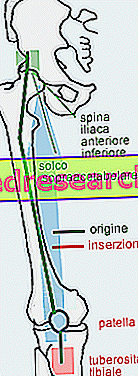Ceftriaxone is a beta-lactam antibiotic belonging to the third-generation cephalosporin class. It has limited efficacy against Gram-positive bacteria compared to first and second generation cephalosporins, but has a higher activity against Gram-negative bacteria.

Ceftriaxone - Chemical Structure
Ceftriaxone has a bactericidal type of antibiotic action (ie it is able to kill bacterial cells).
Indications
For what it uses
Ceftriaxone is used to treat infections caused by bacteria that are sensitive to it.
In particular, ceftriaxone is indicated for the treatment of:
- Meningitis;
- Pulmonary infections;
- Thoracic infections;
- Infections of the middle ear;
- peritonitis;
- Infections of the kidneys and urinary tract;
- Bone and joint infection;
- Skin and soft tissue infections;
- Blood infections;
- Cardiac infections;
- Gonorrhea;
- Syphilis;
- Lyme disease.
Furthermore, ceftriaxone can be used to treat patients with leukopenia who have fever due to bacterial infections.
Finally, ceftriaxone is also used in the prophylactic therapy of surgical infections.
Warnings
Hypersensitivity to other cephalosporins, penicillins or other drugs should be excluded before starting therapy with ceftriaxone.
A lot of caution should be used when administering ceftriaxone in penicillin-allergic patients.
Before starting treatment with ceftriaxone, you must inform your doctor if:
- Products containing calcium have recently been taken;
- There are liver and / or renal pathologies;
- One suffers - or has recently suffered - from intestinal disorders such as diarrhea, inflammation or colitis;
- You have kidney or bile stones;
- One is suffering from haemolytic anemia;
- A low-sodium diet is followed.
Treatment with ceftriaxone may promote the development of superinfections with resistant bacteria or fungi (such as Clostridium difficile or Candida albicans infections).
Clostridium difficile is the main culprit in the development of pseudomembranous colitis which usually manifests itself with the appearance of severe diarrhea.
During treatment with ceftriaxone for long periods, regular check-ups of the blood cell should be performed.
Ceftriaxone must never be administered concomitantly with intravenous solutions containing calcium, as calcium-ceftriaxone crystals may form which precipitate and can cause serious damage.
Ceftriaxone can cause side effects that can affect the ability to drive or use machines, so great care must be taken.
Interactions
During treatment with ceftriaxone - due to possible interactions that may occur - you must tell your doctor or pharmacist if you are taking drugs, such as aminoglycosides or chloramphenicol (other antibiotic drugs).
In any case, it is necessary to inform your doctor if you are taking - or have recently been taken - drugs of any kind, including non-prescription medicines and herbal and / or homeopathic products.
Side effects
Ceftriaxone can cause various types of side effects, although not all patients experience them. The type of side effects and the intensity with which they occur, in fact, depend on the sensitivity that each individual has towards the drug. Therefore, it is not said that all adverse effects occur with the same intensity in each patient.
The following are the main side effects that may occur during ceftriaxone therapy.
Allergic reactions
Ceftriaxone can trigger allergic reactions in sensitive individuals. The symptoms with which these reactions can occur are:
- Sudden swelling of the face, throat and / or lips, resulting in difficulty breathing and difficulty swallowing;
- Sudden swelling in hands, feet and / or ankles;
- Severe rashes with blisters or peeling of the skin.
Gastrointestinal disorders
Treatment with ceftriaxone can cause soft stools or diarrhea, nausea or vomiting, pancreatitis, stomatitis, glossitis and inflammation of the large intestine that manifests itself with symptoms such as diarrhea (often with blood and mucus) stomach pain and fever.
Blood and lymphatic system disorders
Treatment with ceftriaxone may cause:
- Anemia;
- Hemolytic anemia;
- Eosinophilia, ie the increase in plasma concentration of eosinophils;
- Plateletopenia (ie the decrease in the number of platelets in the bloodstream), with consequent increased risk of bleeding;
- Leukopenia, ie the reduction in the number of leukocytes in the bloodstream.
Nervous system disorders
Treatment with ceftriaxone can cause headaches, dizziness, vertigo and convulsions.
Skin and subcutaneous tissue disorders
Treatment with ceftriaxone can cause rashes with wheals, itching and swelling.
Hepatobiliary disorders
Treatment with ceftriaxone can cause abnormal liver function tests and gallbladder problems that occur with pain, nausea and vomiting. Furthermore, the drug can promote the development of bilirubin encephalopathy in newborns.
Superinfections
Treatment with ceftriaxone can promote the appearance of superinfection with bacteria resistant to antibiotics or fungi.
Alterations in laboratory tests
Treatment with ceftriaxone may cause false positives in the Coombs test and in the test for the determination of galactosemia (ie the concentration of galactose sugar in the bloodstream). Furthermore, treatment with the drug can alter the results of certain types of tests that determine blood glucose levels.
Kidney and urinary tract disorders
Ceftriaxone therapy can cause kidney damage due to calcium-ceftriaxone deposits. The symptoms of this type of renal damage consist in a decrease in the amount of urine excreted and in perceiving pain during urination.
Other side effects
Other side effects that may occur during treatment with ceftriaxone are:
- Temperature;
- Increased blood concentration of creatinine;
- bronchospasm;
- Presence of blood or sugar in the urine;
- Edema;
- Chills.
Overdose
If you suspect that you have overdosed, you should contact your doctor immediately or contact the nearest hospital.
Action mechanism
Ceftriaxone is a cephalosporin that performs its bactericidal action by interfering with the synthesis of the bacterial cell wall, the peptidoglycan.
The peptidoglycan is made up of parallel chains of nitrogenated carbohydrates, joined together by transversal bonds between amino acid residues. These bonds are formed thanks to the action of a particular type of enzyme called transamidase.
Ceftriaxone binds to transammidase preventing it from performing its function. In this way, the formation of the aforementioned bonds is prevented and this causes weak areas to be created within the peptidoglycan structure. These weak areas lead to the lysis of the bacterial cell and, consequently, to its death.
Mode of Use - Posology
Ceftriaxone is available for intramuscular or intravenous administration. It is in the form of a powder and solvent for a solution for injection which must be mixed just before the drug is given.
The dosage of ceftriaxone must be established by the doctor on an individual basis, depending on the type and severity of the infection to be treated and on the age and condition of each patient.
Below are some indications on the dosages of ceftriaxone usually administered.
In patients suffering from hepatic and / or renal diseases, a reduction in the usual dose of medication may be necessary.
Adults, elderly and children 12 years of age or older with a body weight of 50 kg or more
The usual dose of ceftriaxone is 1-2 g per day. Your doctor may decide whether or not to increase the dose, up to a maximum of 4 g per day.
Babies, infants and children from 15 days to 12 years of age with a body weight of less than 50 kg
The usual dose of ceftriaxone is 50-80 mg / kg of body weight per day. In case of serious infections, the doctor can increase the dose up to 100 mg / kg of body weight per day, but without exceeding the maximum daily dose of 4g of drug.
Infants from 0 to 14 days old
The usual amount of ceftriaxone used is 20-50 mg / kg of body weight per day. The maximum dose of 50 mg / kg of body weight should never be exceeded.
Pregnancy and breastfeeding
Ceftriaxone is able to cross the placenta, but animal studies have shown no harmful effects on the fetus.
However, the use of the drug by pregnant women should be carried out only after a careful evaluation of the relationship between the expected benefits for the mother and the potential risks to the fetus or newborn and, in any case, it is necessary to ask always consult your doctor.
Ceftriaxone is excreted in small amounts in breast milk, therefore, the administration of the drug in breast-feeding mothers should be done with extreme caution.
Contraindications
Ceftriaxone is contraindicated in the following cases:
- In patients with known hypersensitivity to ceftriaxone itself, to other cephalosporins, to penicillins or to other antibiotics with similar chemical structure;
- In premature newborns;
- In newborns up to 28 days of life who have blood problems;
- In newborns up to 28 days of life with jaundice;
- In newborns up to 28 days of life they should receive injections or intravenous infusions of calcium.



